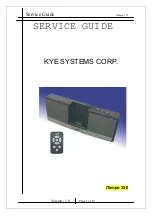
the emitted sound field, diffractions and reflections caused by the cabinet boundaries
are too often overlooked although they are the cause of most of the irregularities
heard and measured in the higher frequency areas.
In that respect conventional rectangular, sharp corner boxes perform especially
poorly. On the other hand, the shape of the System 800 has been designed with
careful attention paid regarding the sculptured front panel to provide smooth,
rounded edges which minimise side diffractions.
Another problem involved in cabinet design is to ensure that the box will effectively
behave as neutrally as possible, ideally without interfering at all with the sound field
emitted by the drive unit and the port. There are two main ways the box can get into
vibration. First there can be a mechanical transfer of energy between the drive unit
and the cabinet front panel. Preventing this requires the use of a rigid and stiff front
baffle, which is achieved on the System 800 by a very thick and compact MDF
panel. The second way the cabinet can get into vibration is by transmission from
acoustical to mechanical energy. Since high acoustic pressures are present inside
the cabinet this is quite likely to occur if no attention is paid in order to minimise it.
Here the use of rigid panels is also helpful but, since their stiffness cannot be infinite
and therefore their resonances only shifted towards higher frequencies, enough
damping has to be provided in the cabinet assembly, including panels and joints.
Due to its octagonal shape and its cabinet construction, the System 800 perform very
well in that respect. Its shape tends to decrease the largest dimensions of each side
panel, which reduce low frequency resonances, while the doubled number of side
provides additional damping.
In addition to the cabinet construction the volume and port tuning have been
carefully calculated to give the best set of parameters for monitoring loudspeakers.
There is a fundamental relationship in loudspeakers between efficiency, cabinet
volume and low frequency performance given that minimal amplitude variations can
be tolerated (as in monitoring situations). The set of parameters that are arrived at
as a solution are inevitably a compromise and the skill of Tannoy has always been
shown to be getting these particular parameters correct for the application.
The Sum of the parts.
The crossover is an important, sometimes difficult part of the design. However the
use of an optimised, well designed drive unit makes the task easier and allows using
simpler networks, which generally give better results.
It is also important to point out that a very important benefit of the Dual Concentric
technology is in connection with the crossover. With conventional discrete multi-
drivers speakers, the crossover has a dramatic effect on the speaker performance in
the frequency range where the different drivers overlap, especially on off-axis
response and on spatial dispersion. Actually, because of the detrimental effects
resulting from the fact that they are non-coincident, the drivers should ideally work in
completely split ranges of frequency. High order low and hi-pass filters are therefore
required to reduce the overlap range. Apart from the fact that it makes the design
more complex, requires more accurate components and increases the costs, a major
drawback is that higher order filters involve increased phase and group delay
distortion, which can be quite perceptible. On the other hand the low order filter used
with Dual Concentric drivers achieve a smooth phase response.
The integration of all the features described above is what makes the whole
loudspeaker system even greater than the sum of the individual parts.
Содержание System 800
Страница 1: ...System 800 USER MANUAL...
Страница 8: ...CURVES Figure 1 On axis anechoic response Figure 2 Impedance...
Страница 11: ...For Tannoy Ltd...






























